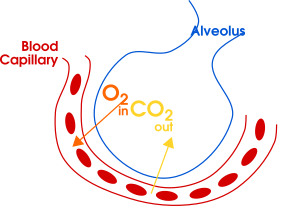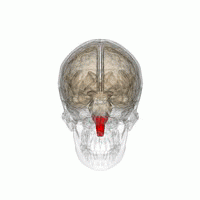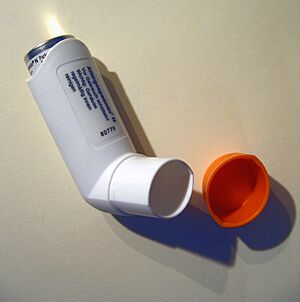Breathing facts for kids
Breathing is how we move air into and out of our lungs. The air we breathe is called a breath. Breathing is super important because our bodies need air to live!
Breathing helps us do two very important things:
- It brings oxygen into our body. Every part of your body needs oxygen to survive. The only way humans can get oxygen is to breathe it in.
- It gets carbon dioxide (CO2) out of our body. When your body makes energy, carbon dioxide is left over. Your body needs to get rid of this extra carbon dioxide. Too much of it can be poisonous. The only way humans can get rid of carbon dioxide is to breathe it out.
When you breathe in, you bring air into your lungs. This air has oxygen in it. The oxygen then moves from your lungs into your bloodstream. At the same time, extra carbon dioxide moves from your bloodstream into your lungs. This is called gas exchange. It's like oxygen and carbon dioxide are trading places! Now, oxygen is in your bloodstream. Your blood can carry this oxygen to every part of your body. The carbon dioxide is now in your lungs, ready to be breathed out.
Adults usually breathe about 18 times every minute. That's more than 25,000 times a day! Children often breathe even faster than adults.
Contents
How Your Brain Controls Breathing
A special part of your brainstem controls your breathing. It's called the medulla oblongata. Groups of tiny brain cells in the medulla tell your breathing muscles when to breathe. They also tell them when to breathe faster or slower.
Your brainstem constantly checks how much carbon dioxide is in your blood. If there's too much carbon dioxide, the medulla tells your body to breathe faster. This helps you breathe out the extra carbon dioxide. Once the carbon dioxide levels are back to normal, your medulla tells your body to breathe slower again.
Your body also checks the amount of oxygen in your blood. If there isn't enough oxygen, the medulla will tell your body to breathe faster. This helps you take in more oxygen. When there's enough oxygen again, your medulla will tell your body to breathe slower.
Your Breathing Muscles
For you to breathe, certain muscles must tighten (contract) and loosen (relax) at just the right times. The special brain cells in your medulla tell these muscles what to do. When they contract, you breathe in. When they relax, you breathe out. There are a few main groups of muscles that help you breathe.
The Diaphragm
The diaphragm is the most important muscle for breathing. It's a flat sheet of muscle located at the bottom of your rib cage. When the diaphragm is relaxed, it looks like a dome or a half-circle.
When your medulla tells the diaphragm to make you breathe in, it pulls down and flattens out. This creates more space inside your chest. This extra room allows your lungs to fill up with air. Air rushes into your lungs, which is called inhalation. When it's time to breathe out, the diaphragm relaxes again, and air leaves your lungs.
The diaphragm does most of the work for breathing. About 60% to 70% of your ability to breathe comes from this muscle.
The diaphragm is controlled by special nerves called the phrenic nerves. The medulla sends messages through these nerves to tell the diaphragm when to contract. The phrenic nerves are very well protected in your body. They are located at the very top of your spinal cord, near your neck.
The Intercostals (Rib Muscles)
The intercostal muscles are found between each of your ribs. When you need to breathe in, these muscles contract. They pull your ribs upward. This also creates more room inside your chest for your lungs to fill.
When you are resting, about 30% to 40% of your breathing ability comes from your intercostal muscles.
The intercostal muscles are controlled by the intercostal nerves. The medulla sends messages through these nerves to tell the intercostals when to contract. These nerves are not as protected as the phrenic nerves. The intercostal nerves run along your thoracic spine. This part of your spine is in your upper to middle back. They connect to your intercostal muscles.
If someone injures their thoracic spine, they might not be able to use their intercostal muscles. This means they would lose 30% to 40% of their breathing ability. However, the nerves for the diaphragm are much higher up and better protected. So, the person would still be able to use their diaphragm to breathe. They would still have 60% to 70% of their breathing ability.
Accessory Muscles
Accessory muscles are muscles you use only when you need extra help breathing. Sometimes, this is normal. For example, if you have just done a lot of exercise, you might need more oxygen. Your medulla will tell your accessory muscles to help out. They make it easier for you to lift your chest. This creates more room for your lungs to fill. The most important accessory muscles are in your chest, abdomen, and neck.
However, if someone has to use accessory muscles to breathe while they are resting, it's a sign they aren't getting enough oxygen. They might need medication, extra oxygen through a mask, or even emergency medical treatment. This helps them breathe normally. For example, people with asthma or chronic obstructive pulmonary disease (COPD) often use an inhaler. The inhaler puffs a medicine like albuterol into the windpipe and lungs. This makes the air passages wider and helps them breathe better.
Related Pages
- Inhalation (breathing in)
- Gas exchange
- Cellular respiration
- Medulla oblongata
- Respiratory tract
Images for kids
-
If exhaled air is breathed out through the mouth in cold and humid conditions, the water vapor will condense into a visible cloud or mist.
See also
 In Spanish: Respiración para niños
In Spanish: Respiración para niños











